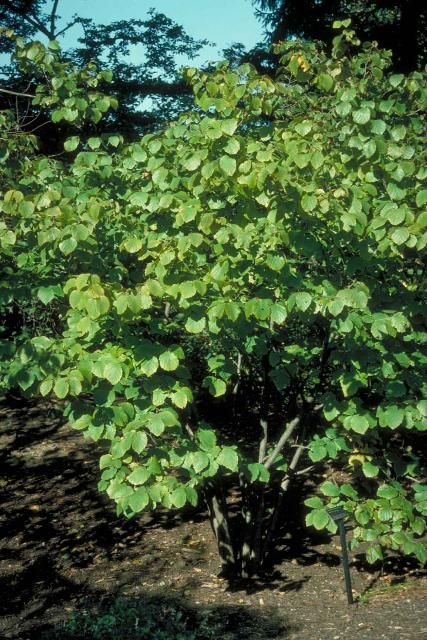Introduction
Witch-Hazel grows best in sun or partial shade and in light, moist soil. The plant tolerates some drought and grows slowly. It grows 20 to 30 feet tall and spreads 15 to 25 feet forming a multistemmed, shrubby, round, somewhat asymmetrical ball. Removing the lower branches helps produce a more tree-form multistemmed specimen but regular minor pruning will be required to maintain it in this form since the plant suckers freely from the base of the trunk.

Credit: Ed Gilman
General Information
Scientific name: Hamamelis virginiana
Pronunciation: ham-uh-MEE-liss ver-jin-ee-AY-nuh
Common name(s): Witch-Hazel
Family: Hamamelidaceae
USDA hardiness zones: 4A through 8B (Fig. 2)
Origin: native to North America
Invasive potential: little invasive potential
Uses: specimen; container or planter; reclamation; highway median
Availability: somewhat available, may have to go out of the region to find the tree

Description
Height: 20 to 30 feet
Spread: 15 to 25 feet
Crown uniformity: irregular
Crown shape: round, vase
Crown density: moderate
Growth rate: slow
Texture: coarse
Foliage
Leaf arrangement: alternate (Fig. 3)
Leaf type: simple
Leaf margin: sinuate/undulate, undulate
Leaf shape: obovate, elliptic (oval)
Leaf venation: pinnate
Leaf type and persistence: deciduous
Leaf blade length: 2 to 4 inches, 4 to 8 inches
Leaf color: green
Fall color: yellow
Fall characteristic: showy

Flower
Flower color: yellow
Flower characteristics: not showy
Fruit
Fruit shape: irregular, round
Fruit length: .5 to 1 inch
Fruit covering: dry or hard
Fruit color: brown
Fruit characteristics: does not attract wildlife; not showy; fruit/leaves not a litter problem
Trunk and Branches
Trunk/bark/branches: branches droop; not showy; typically multi-trunked; thorns
Pruning requirement: needed for strong structure
Breakage: resistant
Current year twig color: brown, gray
Current year twig thickness: thin
Wood specific gravity: unknown
Culture
Light requirement: full sun, partial sun or partial shade, shade tolerant
Soil tolerances: clay; sand; loam; acidic; slightly alkaline; well-drained
Drought tolerance: moderate
Aerosol salt tolerance: none
Other
Roots: not a problem
Winter interest: yes
Outstanding tree: no
Ozone sensitivity: unknown
Verticillium wilt susceptibility: unknown
Pest resistance: resistant to pests/diseases
Use and Management
The fragrant flowers are produced in late fall to early winter and have straplike, yellow petals and is the last shrub to flower during the year. The flowers are more interesting than ornamental, however, there are selections with more showy flowers. The fall color is yellow and often is at its peak when the flowers are out.
Plants are found along stream banks in the shade in its native range where they appear open and poorly branched. However, under cultivation in full or partial sun they develop a fuller, rounded crown. Probably not for clay soils. Although galls are frequently found on the leaves, they are usually not serious pests on the plant.
One cultivar is listed: `Rubescens' - reddish petals.
Pests
Usually no pests are serious.
Saddled prominent is a green to brown or yellow caterpillar with a reddish brown spot on its back. It eats the leaves.
Witch-Hazel leaf gall aphid causes galls 1/2-inch-long. The galls are green, sometimes with reddish tips, and are formed on the upper leaf surfaces. No real lasting harm will be done by these galls. Natural enemies usually control this insect; hand picking and destroying infested leaves will also be helpful. Horticultural oil applied before the plant grows may help control this insect.
The spiny Witch-Hazel gall aphid causes galls 3/4-inch-long with long, coarse spines. The galls are green tinged with red. Both this aphid and the previous one migrate to birch for part of their life cycle. Spray with horticultural oil for some control.
Eastern tent caterpillar feeds on Witch-Hazel leaves. Removing the nest by tearing out the web and crushing the contents or pruning out the infested branch will control the infestation.
Diseases
Usually no diseases are serious.
Several genera of fungi are listed as causing leaf spot on Witch-Hazel but they will not require control.
Various genera of powdery mildew cause a white coating on the leaves.